力扣题目链接
题目
给定一个二叉搜索树, 找到该树中两个指定节点的最近公共祖先。
百度百科中最近公共祖先的定义为:“对于有根树 T 的两个结点 p、q,最近公共祖先表示为一个结点 x,满足 x 是 p、q 的祖先且 x 的深度尽可能大(一个节点也可以是它自己的祖先)。”
例如,给定如下二叉搜索树: root =[6,2,8,0,4,7,9,null,null,3,5]
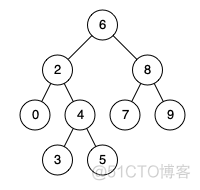
示例 1:
输入: root = [6,2,8,0,4,7,9,null,null,3,5], p = 2, q = 8
输出: 6
解释: 节点 2 和节点 8 的最近公共祖先是 6。
示例 2:
输入: root = [6,2,8,0,4,7,9,null,null,3,5], p = 2, q = 4
输出: 2
解释: 节点 2 和节点 4 的最近公共祖先是 2,
说明:
所有节点的值都是唯一的。递归解法
p、q 为不同节点且均存在于给定的二叉搜索树中。
确定递归函数返回值以及参数:参数就是当前节点,以及两个结点 p、q,返回值是要返回最近公共祖先思路
public TreeNode traversal(TreeNode root, TreeNode p, TreeNode q)确定终止条件:遇到空返回就可以了
if (root == null) {确定单层递归的逻辑:如果
return null;
}
root.val 大于p.val,同时root.val 大于q.val,那么就应该向左遍历(说明目标区间在左子树上)如果root.val 小于p.val,同时root.val 小于q.val,那么就应该向右遍历(说明目标区间在右子树上)需要注意的是此时不知道p和q谁大,所以两个都要判断if (root.val > p.val && root.val > q.val) {剩下的情况,就是cur节点在区间(
TreeNode left = traversal(root.left, p, q);
if (left != null) {
return left;
}
}
if (root.val < p.val && root.val < q.val) {
TreeNode right = traversal(root.right, p, q);
if (right != null) {
return right;
}
}
p.val <= cur.val && cur.val <= q.val)或者 (q.val <= cur.val && cur.val <= p.val)中,那么cur就是最近公共祖先了,直接返回 curreturn root;
代码实现
/**迭代解法
* https://leetcode-cn.com/problems/lowest-common-ancestor-of-a-binary-search-tree/
*
* @author xiexu
* @create 2022-03-14 3:51 PM
*/
public class _235_二叉搜索树的最近公共祖先_二叉搜索树优化 {
public TreeNode lowestCommonAncestor(TreeNode root, TreeNode p, TreeNode q) {
return traversal(root, p, q);
}
public TreeNode traversal(TreeNode root, TreeNode p, TreeNode q) {
if (root == null) {
return null;
}
if (root.val > p.val && root.val > q.val) {
TreeNode left = traversal(root.left, p, q);
if (left != null) {
return left;
}
}
if (root.val < p.val && root.val < q.val) {
TreeNode right = traversal(root.right, p, q);
if (right != null) {
return right;
}
}
return root;
}
}
代码实现
/**701. 二叉搜索树中的插入操作
* https://leetcode-cn.com/problems/lowest-common-ancestor-of-a-binary-search-tree/
*
* @author xiexu
* @create 2022-03-14 3:51 PM
*/
public class _235_二叉搜索树的最近公共祖先_迭代 {
public TreeNode lowestCommonAncestor(TreeNode root, TreeNode p, TreeNode q) {
while (root != null) {
if (root.val > p.val && root.val > q.val) {
root = root.left;
} else if (root.val < p.val && root.val < q.val) {
root = root.right;
} else {
return root;
}
}
return root;
}
}
力扣题目链接
题目
给定二叉搜索树(BST)的根节点root和要插入树中的值value,将值插入二叉搜索树。 返回插入后二叉搜索树的根节点。 输入数据 保证 ,新值和原始二叉搜索树中的任意节点值都不同。
注意,可能存在多种有效的插入方式,只要树在插入后仍保持为二叉搜索树即可。 你可以返回 任意有效的结果 。
示例 1:

输入:root = [4,2,7,1,3], val = 5
输出:[4,2,7,1,3,5]
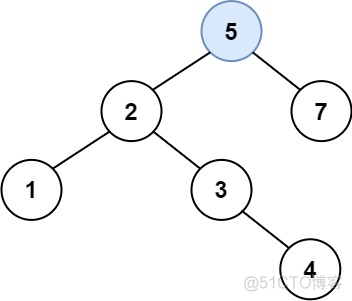
示例 2:
输入:root = [40,20,60,10,30,50,70], val = 25
输出:[40,20,60,10,30,50,70,null,null,25]
示例 3:
输入:root = [4,2,7,1,3,null,null,null,null,null,null], val = 5
输出:[4,2,7,1,3,5]
提示:
树中的节点数将在 [0, 10^4]的范围内。递归解法
-10^8 <= Node.val <= 10^8
所有值 Node.val 是 独一无二 的。
-10^8 <= val <= 10^8
只要按照二叉搜索树的规则去遍历,遇到空节点就插入节点就可以了思路
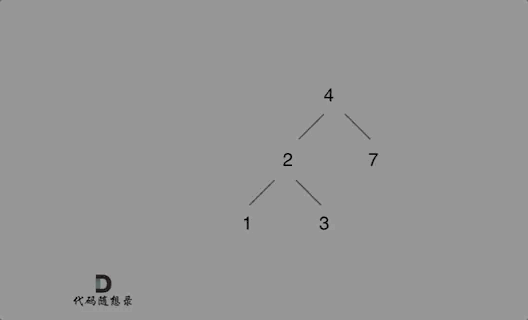
例如插入元素10 ,需要找到末尾节点插入便可,一样的道理来插入元素15,插入元素0,插入元素6,需要调整二叉树的结构么? 并不需要。
确定递归函数参数以及返回值:参数就是根节点指针,以及要插入元素,返回类型为节点类型TreeNodepublic TreeNode insertIntoBST(TreeNode root, int val)确定终止条件:终止条件就是找到遍历的节点为null的时候,就是要插入节点的位置了,并把插入的节点返回
if (root == null) {
TreeNode node = new TreeNode(val);
return node;
}
这里把添加的节点返回给上一层,就完成了父子节点的赋值操作了
确定单层递归的逻辑:搜索树是有方向了,可以根据插入元素的数值,决定递归方向if (root.val > val) {
root.left = insertIntoBST(root.left, val);
}
if (root.val < val) {
root.right = insertIntoBST(root.right, val);
}
return root;
代码实现
/**迭代解法
* https://leetcode-cn.com/problems/insert-into-a-binary-search-tree/
*
* @author xiexu
* @create 2022-03-14 4:30 PM
*/
public class _701_二叉搜索树中的插入操作 {
public TreeNode insertIntoBST(TreeNode root, int val) {
if (root == null) {
TreeNode node = new TreeNode(val);
return node;
}
if (root.val > val) {
root.left = insertIntoBST(root.left, val);
}
if (root.val < val) {
root.right = insertIntoBST(root.right, val);
}
return root;
}
}
思路
在迭代法遍历的过程中,需要记录一下当前遍历的节点的父节点,这样才能做插入节点的操作
代码实现
/**450. 删除二叉搜索树中的节点
* https://leetcode-cn.com/problems/insert-into-a-binary-search-tree/
*
* @author xiexu
* @create 2022-03-14 4:30 PM
*/
public class _701_二叉搜索树中的插入操作_迭代 {
public TreeNode insertIntoBST(TreeNode root, int val) {
if (root == null) {
return new TreeNode(val);
}
TreeNode newRoot = root;
TreeNode pre = root;
while (root != null) {
pre = root;
if (root.val > val) {
root = root.left;
} else if (root.val < val) {
root = root.right;
}
}
if (pre.val > val) {
pre.left = new TreeNode(val);
} else {
pre.right = new TreeNode(val);
}
return newRoot;
}
}
力扣题目链接
题目
给定一个二叉搜索树的根节点 root 和一个值 key,删除二叉搜索树中的key对应的节点,并保证二叉搜索树的性质不变。返回二叉搜索树(有可能被更新)的根节点的引用。
一般来说,删除节点可分为两个步骤:
首先找到需要删除的节点;如果找到了,删除它。示例 1:

输入:root = [5,3,6,2,4,null,7], key = 3
输出:[5,4,6,2,null,null,7]
解释:给定需要删除的节点值是 3,所以我们首先找到 3 这个节点,然后删除它。
一个正确的答案是 [5,4,6,2,null,null,7], 如下图所示。
另一个正确答案是 [5,2,6,null,4,null,7]。
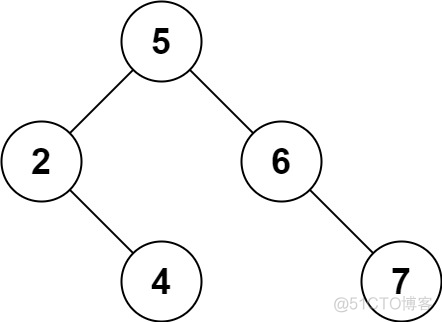
示例 2:
输入: root = [5,3,6,2,4,null,7], key = 0
输出: [5,3,6,2,4,null,7]
解释: 二叉树不包含值为 0
示例 3:
输入: root = [], key = 0
输出: []
提示:
节点数的范围 [0, 10^4].
-10^5 <= Node.val <= 10^5
节点值唯一
root 是合法的二叉搜索树
-10^5 <= key <= 10^5
确定递归函数参数以及返回值:思路
public TreeNode deleteNode(TreeNode root, int key)确定终止条件:遇到空返回,其实这也说明没找到删除的节点,遍历到空节点直接返回了
if (root == null) {确定单层递归的逻辑:有以下五种情况:第一种情况:没找到删除的节点,遍历到空节点直接返回了找到删除的节点:第二种情况:左右孩子都为空(叶子节点),直接删除节点, 返回NULL为根节点第三种情况:删除节点的左孩子为空,右孩子不为空,删除节点,右孩子补位,返回右孩子为根节点第四种情况:删除节点的右孩子为空,左孩子不为空,删除节点,左孩子补位,返回左孩子为根节点第五种情况:左右孩子节点都不为空,则将删除节点的左子树头结点(左孩子)放到删除节点的右子树的最左面节点的左孩子上,返回删除节点右孩子为新的根节点动画中二叉搜索树中,删除元素7, 那么删除节点(元素7)的左孩子就是5,删除节点(元素7)的右子树的最左面节点是元素8。将删除节点(元素7)的左孩子放到删除节点(元素7)的右子树的最左面节点(元素8)的左孩子上,就是把5为根节点的子树移到了8的左孩子的位置。要删除的节点(元素7)的右孩子(元素9)为新的根节点。
return null;
}
代码实现
public TreeNode deleteNode(TreeNode root, int key) {669. 修剪二叉搜索树
if (root == null) {
return null;
}
if (root.val == key) {
if (root.left == null) {
return root.right;
} else if (root.right == null) {
return root.left;
} else {
TreeNode cur = root.right;
while (cur.left != null) {
cur = cur.left;
}
cur.left = root.left;
root = root.right;
return root;
}
}
if (root.val > key) {
root.left = deleteNode(root.left, key);
}
if (root.val < key) {
root.right = deleteNode(root.right, key);
}
return root;
}
力扣题目链接
题目
给你二叉搜索树的根节点 root ,同时给定最小边界low 和最大边界 high。通过修剪二叉搜索树,使得所有节点的值在[low, high]中。修剪树 不应该改变保留在树中的元素的相对结构 (即,如果没有被移除,原有的父代子代关系都应当保留)。 可以证明,存在唯一的答案。
所以结果应当返回修剪好的二叉搜索树的新的根节点。注意,根节点可能会根据给定的边界发生改变。
示例 1:

输入:root = [1,0,2], low = 1, high = 2
输出:[1,null,2]
示例 2:
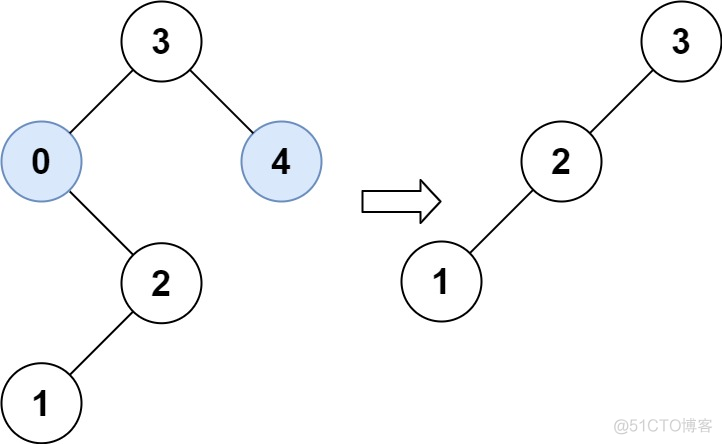
输入:root = [3,0,4,null,2,null,null,1], low = 1, high = 3
输出:[3,2,null,1]
提示:
树中节点数在范围 [1, 10^4] 内
0 <= Node.val <= 10^4
树中每个节点的值都是 唯一 的
题目数据保证输入是一棵有效的二叉搜索树
0 <= low <= high <= 10^4
思路
详细题解见:
代码随想录
代码实现
/**108. 将有序数组转换为二叉搜索树
* https://leetcode-cn.com/problems/trim-a-binary-search-tree/
*
* @author xiexu
* @create 2022-03-14 10:13 PM
*/
public class _669_修剪二叉搜索树 {
public TreeNode trimBST(TreeNode root, int low, int high) {
if (root == null) {
return null;
}
// 如果该节点的值小于最小值,则该节点更换为该节点的右节点值,继续遍历
if (root.val < low) {
TreeNode right = trimBST(root.right, low, high);
return right;
}
// 如果该节点的值大于最大值,则该节点更换为该节点的左节点值,继续遍历
if (root.val > high) {
TreeNode left = trimBST(root.left, low, high);
return left;
}
// root在[low,high]范围内
root.left = trimBST(root.left, low, high);
root.right = trimBST(root.right, low, high);
return root;
}
}
力扣题目链接
题目
给你一个整数数组 nums ,其中元素已经按 升序 排列,请你将其转换为一棵 高度平衡 二叉搜索树。
高度平衡 二叉树是一棵满足「每个节点的左右两个子树的高度差的绝对值不超过 1 」的二叉树。
示例 1:
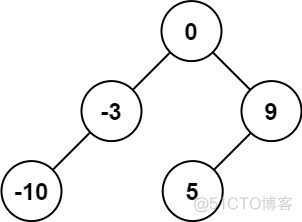
输入:nums = [-10,-3,0,5,9]
输出:[0,-3,9,-10,null,5]
解释:[0,-10,5,null,-3,null,9]
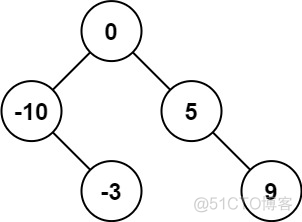
示例 2:
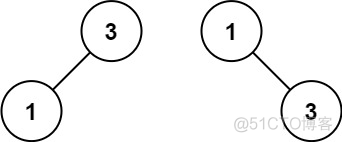
输入:nums = [1,3]
输出:[3,1]
解释:[1,null,3] 和 [3,1]
代码实现
/**538. 把二叉搜索树转换为累加树
* https://leetcode-cn.com/problems/convert-sorted-array-to-binary-search-tree/
*
* @author xiexu
* @create 2022-03-15 9:43 AM
*/
public class _108_将有序数组转换为二叉搜索树 {
public TreeNode sortedArrayToBST(int[] nums) {
TreeNode root = traversal(nums, 0, nums.length - 1);
return root;
}
// 左闭右闭区间[left, right]
public TreeNode traversal(int[] nums, int left, int right) {
if (left > right) {
return null;
}
int mid = left + ((right - left) >> 1);
TreeNode root = new TreeNode(nums[mid]);
root.left = traversal(nums, left, mid - 1);
root.right = traversal(nums, mid + 1, right);
return root;
}
}
力扣题目链接
题目
给出二叉 搜索 树的根节点,该树的节点值各不相同,请你将其转换为累加树(Greater Sum Tree),使每个节点 node的新值等于原树中大于或等于node.val的值之和。
提醒一下,二叉搜索树满足下列约束条件:
节点的左子树仅包含键 小于 节点键的节点。节点的右子树仅包含键 大于 节点键的节点。左右子树也必须是二叉搜索树。示例 1:
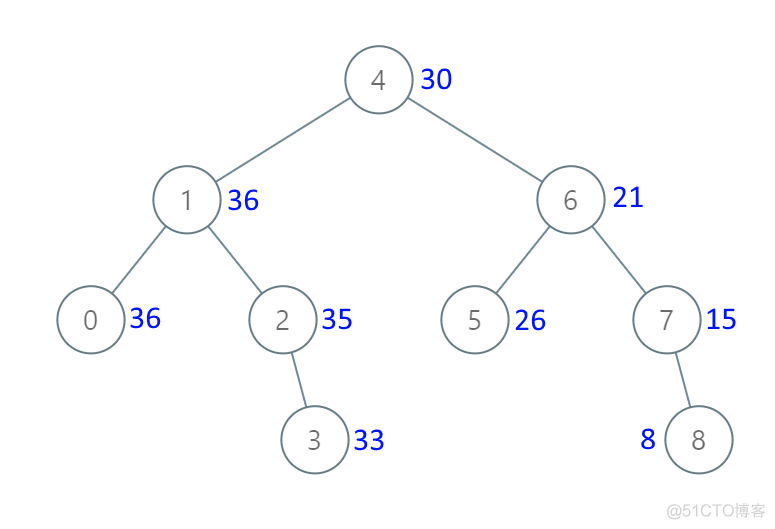
输入:[4,1,6,0,2,5,7,null,null,null,3,null,null,null,8]
输出:[30,36,21,36,35,26,15,null,null,null,33,null,null,null,8]
示例 2:
输入:root = [0,null,1]
输出:[1,null,1]
示例 3:
输入:root = [1,0,2]
输出:[3,3,2]
示例 4:
输入:root = [3,2,4,1]
输出:[7,9,4,10]
提示:
树中的节点数介于 0 和 10^4 之间。递归解法
每个节点的值介于 -10^4 和 10^4
思路
从树中可以看出累加的顺序是右中左,所以我们需要反中序遍历这个二叉树,然后顺序累加就可以了。
代码实现
/**迭代解法
* https://leetcode-cn.com/problems/convert-bst-to-greater-tree/
*
* @author xiexu
* @create 2022-03-15 10:11 AM
*/
public class _538_把二叉搜索树转换为累加树 {
int sum = 0;
public TreeNode convertBST(TreeNode root) {
return traversal(root);
}
// 按右中左顺序遍历,累加即可
public TreeNode traversal(TreeNode root) {
if (root == null) {
return null;
}
traversal(root.right);
sum += root.val;
root.val = sum;
traversal(root.left);
return root;
}
}
思路
迭代法其实就是中序模板题了
代码实现
/**总结
* https://leetcode-cn.com/problems/convert-bst-to-greater-tree/
*
* @author xiexu
* @create 2022-03-15 10:11 AM
*/
public class _538_把二叉搜索树转换为累加树_迭代 {
public TreeNode convertBST(TreeNode root) {
if (root == null) {
return null;
}
traversal(root);
return root;
}
public void traversal(TreeNode root) {
Stack<TreeNode> stack = new Stack<>();
TreeNode cur = root;
// 记录累加值
int sum = 0;
while (cur != null || !stack.isEmpty()) {
if (cur != null) {
stack.push(cur);
cur = cur.right; // 右
} else {
cur = stack.pop(); // 中
sum += cur.val;
cur.val = sum;
cur = cur.left; // 左
}
}
}
}
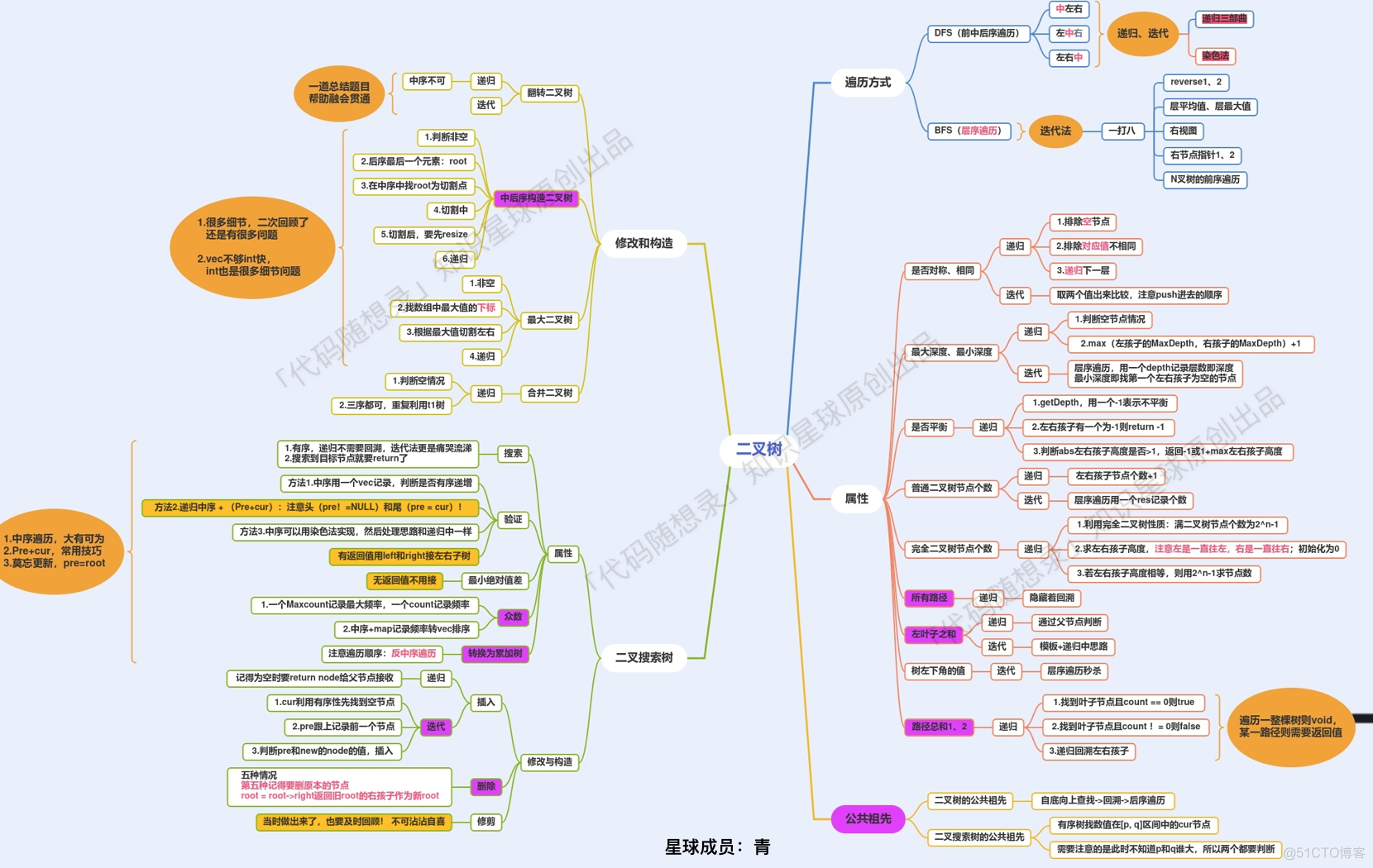







.png)

.png)

